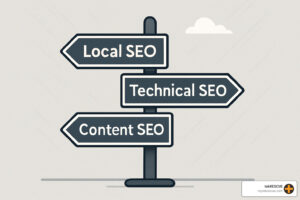

How to Create an Effective Landing Page – Part 3
Your landing page informs what your purpose, services or offerings are. It does this by walking them through the purpose of the organization, into the general services or purpose behind them, and then into the application of those services. Then depending on the organization, there should be an area for a contact box, an estimate form, or a number/email address to connect and interact with you, the owner. We have previously covered these things, but today we go over other potential sections.
There are other things that can be optionally included, such as a small about us page, a testimonial page, or a small portfolio page. These can be smaller than the rest, or all included together in a row. But if you do include an About Us section on the landing page, and also have a separate stand-alone page for About Us, include a link to the full section. Just include the most important information to your brand. This might mean saying how many years you have been in operation, why you started, what you do, the years of experience on your team, how you’ve helped people and any anything else that you as the owner and operator find to be the most important pieces of information.
A testimonial page can be effective, especially with a proper landing page. If the website kept the visitor there and gave them the information or answer(s) they needed or got them interested, then some well placed examples of real customers that benefited from your help can be great to give them reason to contact you or buy your product. A great place to get testimonials is from asking people who have already left you positive reviews on Google or Facebook for a website testimonial. Or just ask their permission to use their review. The effective use of one should add to the flow of the landing page, informing, driving traffic and connecting your potential customers.
If you “create” anything, than a portfolio page would be well-advised. Whether it is your photos you’ve taken, the buildings you have built, whatever it is you create, if the website is mainly about that, then you should definitely consider adding it to the landing page.
There are types of websites that may differ from this formula, however. For example, a personal resume website wouldn’t need to list out the services they offer. And a personal resume website doesn’t always need multiple pages, the landing page may be enough. For that, the idea of breaking down categories into sections, and having an intro and a contact section still stand. But instead of what listing “Catering, Menu and Online Ordering” as your sections, you can have “Resume(employment history), Portfolio, About and Contact”. If you do not have a portfolio, instead you could have a section for skills or references. And an online sales website, may want to use their intro section to advertise flash sales. If you are hosting a non-profit, it will not be your services you will advertise for sale. But rather, the good your organization does, and what donors can expect their money to be used on.
Designing a website correctly can be difficult, but with the proper team behind you it should be able to generate customers and visitors alike.



